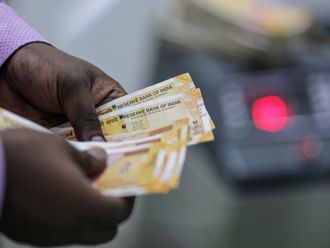The fortunes of Indian financial markets in the coming week, like bourses across much of the world, will be swayed by the US central bank’s much awaited meeting. The Federal Reserve is widely expected to announce on Wednesday the start of rolling back its massive liquidity injection programme as the US economy shows signs of a rebound.
The beginning of the end of the ultra-loose monetary policy by the world’s largest economy will impact India more than any other emerging economy because the country was the biggest recipient of excessive global liquidity in the form of portfolio inflows.
Unfortunately for New Delhi, the turnaround in the US economy coincides with a downswing in India. With growth slumping to 4.4 per cent in the June quarter, the weakest in four years, the outlook for India is weighed down by years of policy paralysis, political corruption and crony capitalism.
“India is caught in a Shakespearean dilemma – to be or not to be,” said a senior executive at a foreign fund that has nearly $1 billion of assets at under management. “Its ailing industrial sector could do with a rate cut, but alas high inflation and a troubled rupee means there is hardly any chance of that happening.”
RBI policy
The Reserve Bank of India, whose new Governor Raghuram Rajan is expected to be more receptive to growth worries than his predecessor, is scheduled to review policy on Friday. It is clear the 50-year-old former professor of University of Chicago will take cues from the Fed decision.
The official at the foreign fund, who did not want to be named, said the US would water down its bond buying programme but is unlikely to move aggressively because of mixed data. The RBI, he said, would likely “stay pat” but hold out the promise of easing in the coming quarter.
The wholesale price index for August, the country’s main inflation gauge that influences RBI policy, is expected to climb towards 6 per cent – the highest in six months – when the data is released on Monday.
Consumer price inflation in August eased slightly but still remained high at 9.5 per cent, while industrial output in July unexpectedly grew 2.6 per cent, but the data was taken with a pinch of salt because of strong headwinds from fuel-price inflation pressure and falling consumer spending.
“We do not believe that the economy is at an inflexion point yet. Risks remain skewed to the downside over the next six months. The growth outlook is very weak, and hence, even as the current account deficit moderates, we expect growth sensitive capital flows -- equity and debt -- to also moderate sharply, leading to pressure on the balance of payment,” said Sonal Varma, economist at Nomura.
Stagflation risk
She said inflation pressure arising from the rupee’s depreciation would push up the wholesale price index, while companies will likely see their profit margins being squeezed due to weak pricing power.
“Weak demand and cost-push inflation will likely result in a stagflation-type scenario in India over the coming period. Risks of a fiscal slippage are rising and the only way to stick to the budgeted fiscal deficit target (of 4.8 per cent of GDP) will be to cut spending, which will hurt growth,” Varma said.
“On the policy front, we expect the repo rate to remain on hold at the 20 September policy meeting and we are pencilling in 75 basis points of cumulative repo rate cuts in fiscal year 2015.”
So, how would all this play out on the markets?
“We believe that some (US) tapering off is already priced in and to that extent, if the actual amount of taper matches expectation, it may not be taken negatively by the markets,” said Dipen Shah, head of private client group research at Kotak Securities.
Others, however, think stocks may have rebounded too sharply and could come under pressure. Although foreign portfolio investors have turned net buyers, grabbing garage-sale bargains that looked more attractive thanks to a sharp drop in the rupee’s value against most currencies this year, there is fear in the air of another round of extreme volatility with a negative bias.
Indeed some analysts believe the stocks rally – the top-30 Sensex rose 2.4 per cent and the 50-share Nifty climbed 3 per cent in the week to Friday – could be tempting for large funds to sell out. And in a sign of what could be expected, the benchmark Sensex ran into severe resistance after it climbed above 20,000 for the first time in months. It ended the week at 19,732.76.
The rupee also continued its rally, helped in part by central bank intervention and a pickup in inflows, but the speed of the rebound since hitting a record low of 68.85 against the US dollar in late August could be its undoing especially with fundamental factors showing little change.
The Indian currency closed at 63.50, gaining 2.8 per cent on the week, its biggest weekly rise in 15 months.
The markets will also be watching political developments, particularly the appointment of Narendra Modi as the prime ministerial candidate of the opposition Bharatiya Janata Party in the national elections due by next May.
“The Indian stock market’s greatest hope,” Christopher Wood, chief equity strategist at CLSA Asia Pacific Markets told the Economic Times, “is the emergence of Gujarat Chief Minister Narendra Modi as the BJP’s prime ministerial candidate.”
The writer is a journalist based in India.












